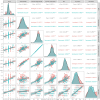Body condition scoring facilitates healthcare monitoring in Hermann's Tortoises (Testudo hermanni ssp.)
- PMID: 38635596
- PMCID: PMC11025769
- DOI: 10.1371/journal.pone.0301892
Body condition scoring facilitates healthcare monitoring in Hermann's Tortoises (Testudo hermanni ssp.)
Abstract
Clinical assessment of body condition is crucial in captive and free-ranging reptiles, since a large percentage of diseases result from inadequate nutrition. However, preventive health care is restricted by the lack of a practical method for the assessment in tortoises. Pre-existing evaluation systems based on weight and shell measurements are laborious and ignore the clinical presentation of the animal. The present study aimed to facilitate the assessment by establishing a body condition score. A total of 373 Hermann's Tortoises (Testudo hermanni) (n = 281 tortoises kept as pets in Germany and n = 92 tortoises originating from a free-ranging population (68) or a rearing station (24) in France) were examined and data (weight (g), carapace length (cm), width (cm), height (cm)) were recorded in a standard protocol between October 2020 and October 2021. A modified version of a body condition score for Mojave Desert Tortoises (Gopherus agassizii) (1 = cachectic, 3 = ideal, 5 = obese) was utilized and tested against pre-existing shell measurement systems (Jackson's ratio, body condition index, volume condition index, circumferential product). German captive tortoises were significantly heavier and larger than French specimens. In the Spearman's correlation matrix, the body condition score showed a statistically significant correlation with all measurement methods in the total population of captive tortoises (Testudo hermanni boettgeri), with a medium correlation strength, and a lack of correlation in free-ranging tortoises (Testudo hermanni hermanni). However, individual animal data suggested misleading results of mathematical equations in terms of body condition. Clinical evaluation of tortoises, including a body condition score, should be considered essential to provide good healthcare and should be an integral part of general examination.
Copyright: © 2024 Frankenberger et al. This is an open access article distributed under the terms of the Creative Commons Attribution License, which permits unrestricted use, distribution, and reproduction in any medium, provided the original author and source are credited.
Conflict of interest statement
The authors have declared that no competing interests exist.
Figures








Similar articles
-
Morphological Divergence of Hermann's Tortoise (Testudo hermanni boettgeri Mojsisovits, 1889) in Albania.Animals (Basel). 2021 Jan 9;11(1):134. doi: 10.3390/ani11010134. Animals (Basel). 2021. PMID: 33435316 Free PMC article.
-
Basal cell carcinoma in two Hermann's tortoises (Testudo hermanni).J Vet Diagn Invest. 2016 Nov;28(6):750-754. doi: 10.1177/1040638716668560. Epub 2016 Sep 29. J Vet Diagn Invest. 2016. PMID: 27694187
-
Evaluation of intraocular pressure in conscious Hermann's tortoises (Testudo hermanni) by means of rebound tonometry.Am J Vet Res. 2012 Nov;73(11):1807-12. doi: 10.2460/ajvr.73.11.1807. Am J Vet Res. 2012. PMID: 23106468
-
Diseases of the respiratory tract of chelonians.Vet Clin North Am Exot Anim Pract. 2000 May;3(2):537-49, viii. doi: 10.1016/s1094-9194(17)30088-9. Vet Clin North Am Exot Anim Pract. 2000. PMID: 11228895 Review.
-
[Assessment of the nutritional condition in Mediterranean tortoises (Testudo spp.) - an overview].Tierarztl Prax Ausg K Kleintiere Heimtiere. 2024 Dec;52(6):367-374. doi: 10.1055/a-2435-0356. Epub 2024 Dec 5. Tierarztl Prax Ausg K Kleintiere Heimtiere. 2024. PMID: 39637919 Review. German.
Cited by
-
Inter-evaluator bias and applicability of feline body condition score from visual assessment.Front Vet Sci. 2025 Aug 18;12:1604557. doi: 10.3389/fvets.2025.1604557. eCollection 2025. Front Vet Sci. 2025. PMID: 40901064 Free PMC article.
References
-
- Krautwald-Junghanns M. Haltung exotischer Tiere und Wildtiere in Privathand: Situationsanalyse, Bewertung und Handlungsbedarf insbesondere unter Tierschutzaspekten (EXOPET). Abschlussbericht Bundesanstalt für Landwirtschaft und Ernährung [Internet]. 2018. [accessed Mar 2024] Available from: https://service.ble.de/ptdb/index2.php?detail_id=57204&ssk=9ddea1dad7&si... [German].
-
- van Dijk PP, Corti C, Mellado V, Cheylan M. Testudo hermanni (errata version published in 2020) e.T21648A176604335. The IUCN red list of threatened species 2004.
-
- Ballouard J-M, Conord M, Johany A, Jardé N, Caron S, Deleuze S, et al.. Is popularity a double-edged sword? Children want to protect but also harvest tortoises. J Environ Educ. 2020;51(5):347–60.
-
- Donoghue S. Nutrition. In: Mader DR, editor. Reptile medicine and surgery. 2 ed. St. Louis (MS): Elsevier; 2006. p. 274–6.
MeSH terms
LinkOut - more resources
Full Text Sources

